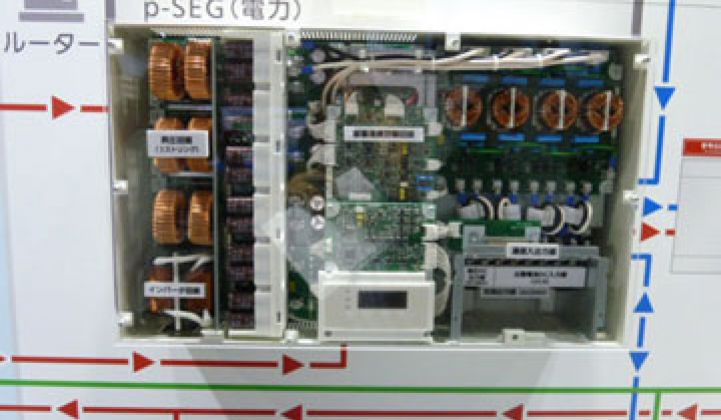Tokyo -- Panasonic laid out a plan today to weave together its many divisions to become the largest company in the world when it comes in green electronics.
By 2018, the company wants to obtain 30 percent, or 1 trillion yen ($12 billion) of its expected revenue from its energy systems business. Now, the group accounts for approximately 15 percent of the company's revenue.
Panasonic also hopes to hit a carbon dioxide peak from its operations and from the way consumers use its products to peak in the same year. If it hits this mark, carbon emissions will be roughly level with 2010 emissions and 120 million tons less than a business-as-usual scenario.
Approximately 16 percent of the materials used in new products will come from reclaimed and recycled materials and 99.5 percent of waste generated at factories will be recycled. It will place an emphasis on replacing conventional chemicals with sustainable materials.
The goal will largely come from three large product groups: energy efficient appliances, components and grid equipment; batteries and power storage; and renewable energy systems like solar panels and fuel cells. Ideally, Panasonic will be able to position itself as a global supplier, in a manner similar to the strategy taken by General Electric and Siemens in recent years.
“We are trying to offer a whole solution,” said Fumio Ohtsubo, Panasonic’s president, in a meeting with reporters at the Panasonic Center in Tokyo.
Ohtsubo even mentioned that Panasonic is working on an ethanol car project in Brazil. (More on specific products below.)
The strategy derives from equal parts of opportunity and desperation. The growing market in green technology prompted a corporate reorganization in recent years. It bought 51 percent of Sanyo, a major supplier of lithium-ion batteries and solar panels, and will likely buy the remainder in 2011. It also absorbed Matsushita Electric, an industrial equipment supplier and a sister company within the conglomerate.
The push toward green, meanwhile, will also help Panasonic diversify from consumer electronics, an industry hit hard by commoditization.
“We needed to produce a new line of business,” he said, adding that energy provides “a lower risk of commoditization.”
Solar manufacturers will either scoff or be amazed at that last statement.
“After the financial crisis, the Japanese economy was hard hit,” he added. “That has dealt a big blow, particularly to the manufacturing industry.”
In a sense, Panasonic is going back to its roots. The company will turn 100 years old in 2018. Its first product was an “attachment plug.” It screwed into light sockets and let consumers tap into power to run other appliances. In 1918, Japanese homes didn’t have wall sockets so the attachment was the only way to use electricity for things other than bulbs. Ohtsubo then pulled out one of the original attachments from his pocket and noted that the company made them from the screw-in base from recycled Edison bulbs.
What does holding the number-one slot in green electronics mean? The sprawling category defies easy categorization, but Panasonic will largely concentrate on producing brand name products like dishwashers, LED light bulbs and refrigerators, as well as those faceless electronic components found in everything.
At Ceatec, the large electronics trade show taking place outside of Tokyo this week, the company showed off a number of products that flesh out the strategy. Some of the ideas:
--The Smart Energy Gateway. See picture. The SEG is effectively a home energy monitor. It connects to appliances and electric cars, can potentially control lights and other appliances, and can also send and receive signals to and from utilities and demand-response providers.
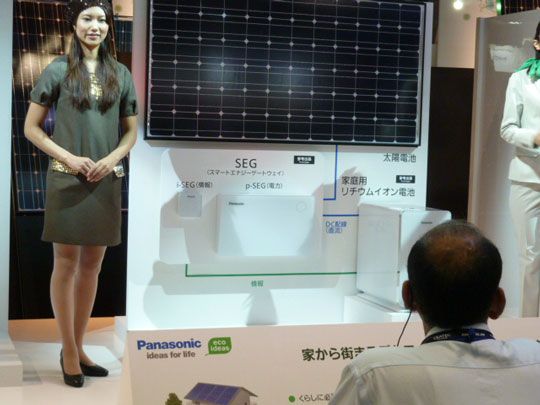
A lot of companies have similar devices, but the SEC is somewhat interesting-looking.
--The spying refrigerator. The Eco Navi refrigerator is festooned with motion, light and temperature sensors to reduce energy consumption. When the light sensor determines that it is nighttime, it will let the temperature inside the fridge float up a few degrees to save energy without risking spoilage. Conceivably, the light sensor could also be used to trigger the defrost cycle to run at night instead of at peak times.

More interestingly, it also studies your usage patterns. If you tend to go to the fridge at 8 a.m., noon and between 6 p.m. and 8 p.m., it eases back on cooling during off-hours to save more energy. While the SEG is a prototype, the Eco Navi fridge is already on sale in Japan.
--The smart air conditioner. The Eco Navi air conditioner comes with motion and other sensors to determine the location of individuals and activity levels in a room. If one side of the living room is occupied with chairs and you’re doing jumping jacks in another part, it directs more air toward you.
--The mileage-boosting air conditioner. The company has created a heat-pump air conditioner for cars. It takes heat from the engine, runs it through heat pumps and exchangers and then uses the energy harvested to cool the car.
--The dual-sided solar panel. From Sanyo, Panasonic has inherited the Hit solar panel. It combines a layer of crystalline and a layer of amorphous silicon to boost power production. To further boost energy output, it has a version called the Hit Double, which contains another Hit module on the backside. If propped 50 centimeters to one meter above a white roof, the Hit Double can boost power production by 30 percent.
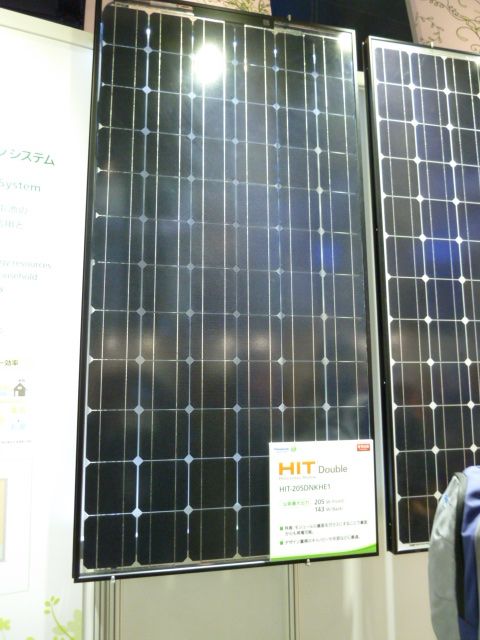
It sells a version of the panel in Germany and may take it to other markets. Solyndra in the U.S. has received a ruling from the IRS that building owners can get tax credits on new roofs that reflect light onto solar panels. The Hit Double effectively does the same thing; thus, Panasonic could become the second company to take advantage of this benefit.
--The stylish storage system. See that white box on the ground? That’s a six-kilowatt-hour lithium-ion storage system. It contains four battery modules containing 140 lithium-ion cells each. The company will try to release it in 2011. Like the SEG, the home storage system is the sort of thing other companies make too, but Panasonic does have a history in industrial design and mass manufacturing. Hence, it comes to the market with a few potential advantages.
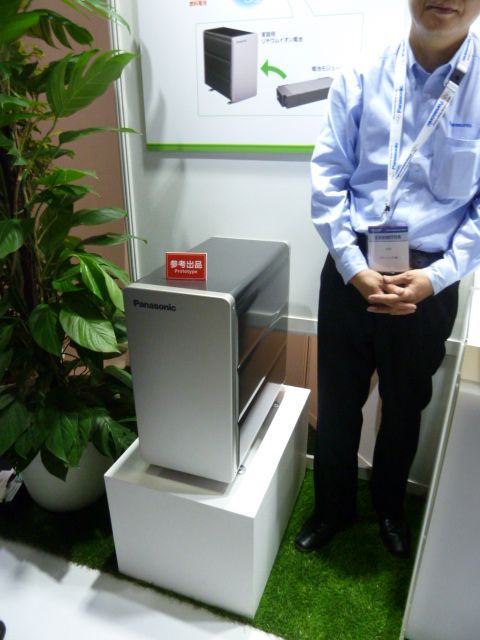

--Home fuel cells. The company, in cooperation with local utilities, has already installed 2,000 natural fuel cells in homes. The fuel cells generate both electricity and heat. (By contrast, Bloom fuel cells go into commercial buildings and produce more electricity but very little heat.)
Fuel cells are attractive in Japan because gas companies don’t sell electricity and vice versa. Fuel cells, as a result, represent one of the few ways for gas companies to gain market share. But, like solar panels, the price remains a bit high and the market relies on subsidiaries.
Panasonic also showed off a methanol fuel-cell prototype. Right now, the prototype is only around 20 percent to 25 percent efficient. The company hopes to get it to market in four years or so.
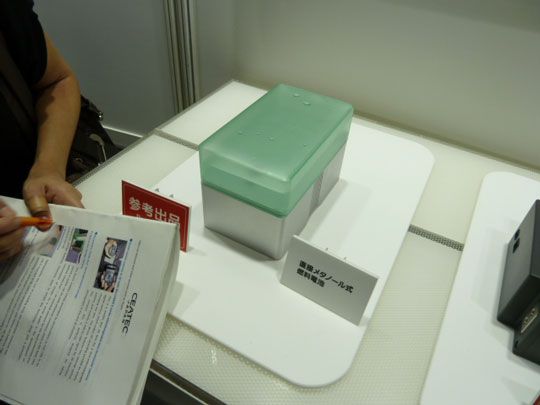
--TVs and everything else. While 30 percent of revenue will come from the energy group, the company will work to reduce power consumption in TVs and other appliances. It has, too. Regulators have begun to pass laws restricting power consumption.
